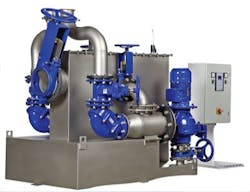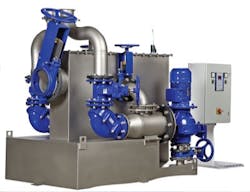Exhibitor promotion: KSB
Wastewater and Extraction Pumps on Show from KSB
Transferring untreated wastewater and effluent from locations where there is insufficient gravity flow into a mains sewer presents considerable difficulties for operators of pump stations.
The main problem that operators have to contend with is pump and system failure due to pumps becoming blocked with solids.
Screening can to a certain degree remove large objects, but it is the steady build up of matter that is often the main cause of pump failure. Removing blocked matter from pumps is a time-consuming, costly and thoroughly unpleasant procedure, which often has to be undertaken as an emergency.
In an effort to address this issue, KSB has developed a wastewater pump station package that includes a patented dry-installed solids separation system. This system ensures that the transfer pumps do not become clogged or damaged due to the presence of the upstream separator. The AmaDS³ has been designed specifically for buildings and complexes that require the availability of a wastewater/effluent pumping station at all times.
Providing economic operation and system reliability, the AmaDS³ is a combination of a closed gas tight separation system and two wastewater pumps (one duty and one standby) in a back pull-out design.
The AmaDS³ functions by allowing untreated wastewater/effluent to flow into the unit whereupon it enters the separator. This collects solids but allows the water to drain through into a collecting tank where it is held until a preset level is reached.
Once that level has been reached, the intake check valve is closed and the duty pump is automatically started pumping the treated water into the discharge line and through the separator, in the process flushing the solids out into the discharge line and out of the pump station. Once this process has been completed and the water level in the collecting tank is back at a minimum level, the intake check vales opens and wastewater/effluent starts to flow into the separator.
As the wastewater handled by the pump's hydraulic system is mechanically separated from the solids content at the point of entry, pumps with smaller free passages and highly efficient hydraulic systems can be used.
This enables operators to achieve considerable energy savings and to keep operating costs down. Even in the case of high heads or long discharge lines AmaDS³ is a viable solution for the economic and efficient transport of untreated wastewater and effluent.
Since the pumps handle solids-free water only, the risk of wear and clogging is extremely low. As a result, the service life of the entire station is longer than that of conventional systems. Redundancy of all the main components, together with the separators being located outside the water collecting tank, means that the system can be serviced and repaired while it is in operation.
The back pull-out configuration enables the pumps and the system's other key components to be accessed comfortably and without maintenance personnel getting wet or exposed to hazardous materials. The collecting tank is gas-tight and features a central vent.
KSB's AmaDS3 is available in six different sizes and the standard model has a maximum head is 85m. The inflow rate varies between 6 and 120m³/h and the water collecting tanks have a capacity of between 220 and 2,400 litres.
Submersible pumps for water extraction
Water extraction pumps are often subjected to challenging operating conditions, particularly in respect to the volume of the solid content in the water being extracted. What is needed is a robust pump capable of withstanding abrasive wear. KSB Aktiengesellschaft is meeting these challenges with its UPA 250C submersible borehole pump range, which can be also seen at this year's IFAT exhibition.
KSB's UPA series is intended for use in general water supply, irrigation, mining, groundwater drawdown and management, fire-fighting and pressure boosting applications. The pumps have a maximum discharge head of UPA 250C of 460m and a maximum flow rate of 330m³/h and depending on the motor selected, fluid temperatures up to 50°C can be handled. Such is the robust design and construction of the UPA 250C pump, it can be used for pumping water with solids contents of up to 50g/m³. A patented sand separator protects the pump against abrasive wear and the pump's encapsulated bearings are maintenance-free.
The operating reliability of the pump is further increased by the use of a check valve with anti-blockage valve disc, and its integrated spring prevents water hammer due to the minimum closing time. This contributes to protecting the entire well system and all of its components. A wear-resistant mechanical seal keeps the pumped fluid from mixing with the fluid in the motor space, thus enhancing the motor's availability.
The motor thrust bearing is water-lubricated and fitted with self-aligning tilting pads. Requiring no maintenance, it easily copes with the stresses and strains of continuous operation thanks to the material combination of stainless steel and hard carbon. The dynamically balanced rotor makes for smooth running of the pump set.
On start-up the pump's counter thrust bearing absorbs the axial thrust generated by the hydraulic system and, in doing so, keeps the impellers from rubbing on the stage casings. This ensures high operating reliability and enables the kind of long-term operation that is expected of water extraction pumps. All the UPA pumps are available in different material variants, depending on the intended application and all wetted plastic components are certified for drinking water applications.
The KSB range of submersible borehole pumps covers a flow rate range of roughly 1 m³/h to 2,700 m³/h. The type series dependent discharge heads peak at 1,550 m.
www.ksb.com
More Water & WasteWater International Current Issue Articles
More Water & WasteWater International Archives Issue Articles


